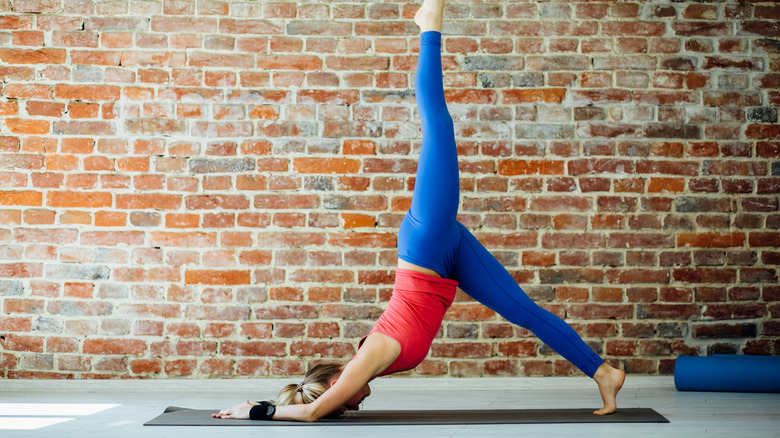The Benefits Of Doing Dolphin Pose In Yoga
Dolphin pose might not be one of your standard yoga poses, but it's a great option for people whose wrists might be hurting from too many downward dogs and chaturangas, according to CNY Healing Arts. The pose actually looks like downward-facing dog pose, but your forearms stay on the mat. You'll still get the leg and back stretch from a downward dog, but you'll definitely notice the pose feels different when you drop to your forearms.
Also called "ardha pincha mayurasana," dolphin pose lets you feel what it's like in an inversion because more blood flows to your head, according to Siddhi Yoga. You'll also feel the muscles in your upper back, shoulders, triceps, and biceps work hard in this pose. Because dolphin pose is a semi-inversion, it takes off gravity's pressure on the spine. You might feel rejuvenated as you feel your spine extend in dolphin pose. If you stay and breathe in this pose for a while, you'll notice it can calm the mind. A calm mind can lead to better sleep. Dolphin pose can often prepare you for more advanced inversions such as headstand and forearm balance.
How to do dolphin pose
If you'd like to give dolphin pose a try, start on the floor (or your mat) on your hands and knees. Bring your forearms to the floor so your shoulders, elbows, and hands are on the same line. With your hips directly above your knees, tuck your toes under. While pressing into your forearms, raise your hips off the floor. Keep a slight bend in your knees if your hamstrings are tight or you feel your lower back rounding. You can also bring your feet closer or farther away from your forearms according to your body's structure.
As best as you can, imagine someone pulling your tailbone toward the ceiling to help extend your spine. As your body begins to acclimate to the pose, keep pulling the tailbone up and away from your shoulders. Your body should look like an inverted V shape from your shoulders to your heels. Avoid hunching through your shoulders. Instead, keep your shoulders active by using your palms and forearms to press the floor away from you. Once you establish yourself in the pose, feeling active in your upper and lower body, breathe deeply for three to eight breaths. Release yourself out of the pose by bending your knees back towards the floor (via CNY Healing Arts).
Dolphin pose modifications
Because dolphin pose will have your head below your heart, you should avoid the pose if you have high blood pressure, glaucoma, or a recent stroke, according to Yoga Journal. You might want to avoid dolphin pose if you have any shoulder injuries like an impingement or torn rotator cuff.
Unstable shoulders could also make dolphin pose particularly difficult, so you can use a strap to work on your shoulder stabilization. Just before you come down onto your hands and knees, loop a strap just above your elbows and secure the loop so that your elbows are about the width of your shoulders. As you come onto the floor, place a block on the lowest setting to keep the proper distance between your hands. You can step your feet back into a plank pose to help engage your core, or you can try to raise your hips into dolphin pose with your shoulders secure.
Once you've mastered dolphin pose, you can add a little spice by raising one leg off the mat or walking your feet closer to your elbows. You can try dolphin pushups by drawing your chin towards your hands and then pressing back up into the pose. Dolphin pose can also be more challenging if you lift your elbows an inch or so off the mat (via Ekhart Yoga).



